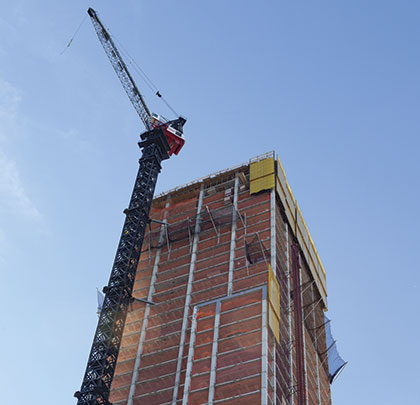Whether you’re aware of it or not, you’re always looking out for your personal safety, as well as for others. Don’t believe it? Think about how you look both ways before crossing the street. Or, how you instinctively know not to touch a hot burner on a stove. Or, how you plunk a helmet on your 5-year-old’s head before he/she heads out for an exhilarating bike ride up and down your driveway.
Many of these are reflexive, unconscious actions that allow people to maneuver safely in the world. However, there’s another kind of safety—the kind that requires active thinking and planning in order to keep workers, pedestrians, and even buildings, safe. That’s the kind of safety that requires Strong Man.
THE TALLEST TOWER PROJECT
What do the Goldman Sachs tower at 781 feet and Trump Plaza at 532 feet have in common? They’re both shorter than the 950-foot tower at 99 Hudson Street built by China Overseas America, completed in 2015, that was, at the time, the tallest building in Jersey City, New Jersey.
Before construction began, Mayor Steve Fulop released a statement calling the tower, “a milestone moment for Jersey City.” The 95-story completed tower houses 760 condo units, approximately 18,000 square feet of commercial and retail space, and an expansive 7,000-square-foot park.
During construction, Strong Man’s orange fire-retardant SBN-22 (10 ft, 6 in x 150 ft) was used on the job. Strong Man’s most popular debris netting provided the floor-to-ceiling protection required to prevent debris from falling off the building and endangering pedestrians or equipment below.
FLOOR-TO-CEILING: A NEW TREND
An intriguing difference on this project was the floor-to-ceiling netting. Jay Kinder, founder and CEO of Strong Man, notes the floor-to-ceiling trend in debris netting is relatively new.
“For years, the 10 foot, 6 inch netting was kind of the ugly stepsister of the debris tarp world,” says Kinder. He notes that, historically, sales were always strong for 4-foot netting, slowly creeping up over the years to 5 feet, 6 feet, and then 8 feet, 6 inches for scaffolding.
So what’s changed? An increased interest in, and adherence to, safety, for one thing.
“The floor-to-ceiling netting as seen at 99 Hudson Street creates a cocoon system,” says Kinder. “Visually and pragmatically, it makes people feel safe. And, in fact, it does increase their safety.”
Kinder notes city inspectors are fans of the full netting, which fully covers the open side of a building so nothing can fall out.
“The netting is a great way to protect workers,” he notes. “It’s bright orange, so people can see it. It prevents debris and tools from falling. It protects pedestrians. And, it protects adjacent properties. Just because you’re doing construction doesn’t mean the buildings next door are going to welcome floating debris.”
With the New Jersey side of the Hudson River experiencing a blast of building activity, expect to see more of this type of debris netting.
“It does its job, which is why it brings people peace of mind,” says Kinder.

FIRE RETARDANT AND THIRD-PARTY TESTED
Preventing debris from plunging to the earth below is only half the battle, however. True safety requires that debris netting meet requisite fire-retardant standards. Strong Man tests every container of debris netting, thus ensuring that its material meets NFPA 701 Method II. That’s not something required. So, why is it done?
Because, Strong Man believes that a safety product should live up to its name and perform like a safety product. More often than not, the fire retardancy of our debris netting doesn’t come into play. But if it does, don’t you want the peace of mind knowing you can count on the netting you have installed? That’s why Strong Man has every single container tested by an independent lab.
COMMON USES FOR DEBRIS NETTING
Common uses for SBN-22 include construction and jobsite protection, debris, worker and pedestrian safety, scaffold enclosure, and industrial, plant, and refinery maintenance, just to name a few. According to Strong Man, “If you can build it or work on it, SBN-22 can protect it.”
ABOUT STRONG MAN
Safety, service, and the best-in-class debris netting and construction tarps in the business—that’s the Strong Man way. Since 1974, quality and reliability have been its strengths. It is a family owned business whose history in the industry goes long and deep. That’s why dealers and customers alike trust and prefer Strong Man.
Strong Man’s debris netting has been used on Notre Dame stadium, the Princeton Library, the historic Saint Thomas Church on 53rd Street in Manhattan, the new World Trade Center in Manhattan, the Chapel at Duke University, the Tulsa library, and many more.
SBN-22 is Strong Man’s most popular debris netting, available with both fire-retardant and non-fire-retardant attributes, and may be used in a wide variety of applications. This cost-effective, UV-treated product is made from knitted high-density polyethylene mesh and comes with a reinforced border. With hole openings of approximately ¼ inch, it meets NYC Local Law #61 and OSHA requirements. Lightweight and durable, Strong Man’s mesh stays flexible in cold weather. ■
For More Information: For more information about Strong Man and the SBN-22 safety debris netting used on a variety of jobs, visit www.strongman.com.
_________________________________________________________________________
Modern Contractor Solutions – August 2016
Did you enjoy this article?
Subscribe to the FREE Digital Edition of Modern Contractor Solutions magazine.

The Safety Net


